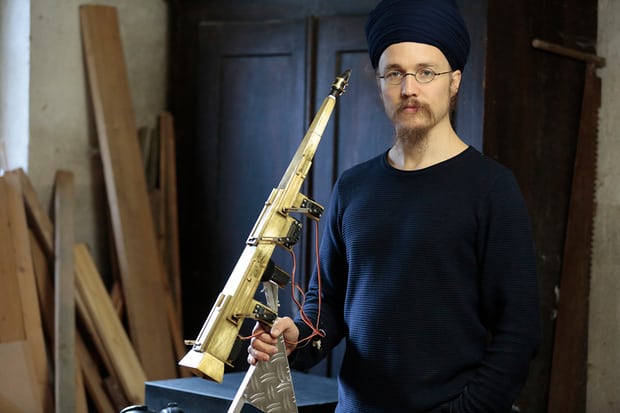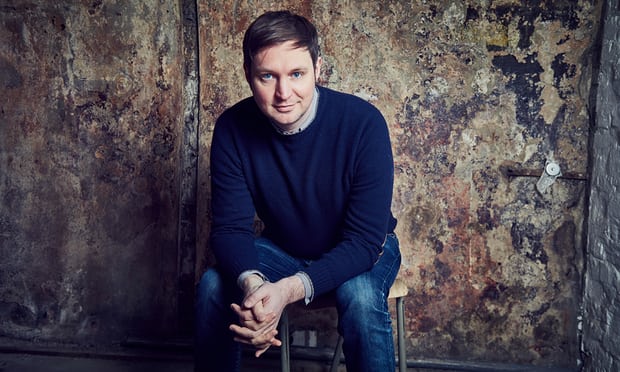A boom In Inventing New Musical Instruments
‘The status quo will be obliterated!’ – the inventors making their own musical instruments
Hundreds of people are beavering away, hoping to create their own game-changing instrument – but most won’t sell a single one. Will any change the future of music?

A woman uses Roli’s Seaboard.
Subhraag Singh’s house is down a hill from a bakery in a quiet suburb of Stuttgart, where everyone’s garden is neatly kept. If someone turned their music up too loud, you imagine the neighbourhood watch would give them a ticking off. It doesn’t look like the home of the future of music. But propped up in Singh’s study is an instrument he claims will “change the way music functions”. He made it in his basement and it is called the Infinitone.
On his website, he is even more enthusiastic. The Infinitone is “the saxophone of the future”, he writes – the first instrument capable of opening “infinite musical universes”. “The status quo in music from this point forward shall be obliterated!” Music will “never be the same again”.
Singh kneels behind the Infinitone, puts his lips around its mouthpiece and blows. The sound at first is nothing special. But then he starts playing a keyboard by his side, hitting the odd button on an iPad, and something magic happens: five arms start rushing up and down, motors whirring, as if they are trying to leap on to his face (“It’s alive,” he jokes). The arms are opening holes to precise points so that Singh can play any note imaginable – ones, perhaps, no one has heard before.
“Now we’re travelling to the pyramids,” he says at one point, then makes a noise like John Coltrane blaring his way across the Middle East. “And now the Himalayas.” Within seconds we have travelled there, too. The music keeps changing location with each breath. Although at times it just sounds like an out-of-tune sax.
You would be forgiven for thinking instrument-making reached its endpoint long ago. The orchestra has largely been fixed since the Belgian Adolphe Sax patented his eponymous instrument in the 1840s. And these days, a standard laptop can make so many sounds, why would we need anything new?
But there are hundreds, even thousands, of instrument inventors beavering away. There is Jan Heinke, a German who has decided the world needs a set of steel rings that you play like cellos, and Yuto Hasebe, a Japanese artist trying to make a new instrument out of deer antlers. There is Ly Yang, who has stuck two zithers together (and called it a Lyharp), so she can play heavy metal covers at the same time as Chinese music. And Caleb Byerly, a missionary who invented the Salimbaa, a 36-stringed east Asian instrument, because God sent it to him in a vision.

‘It will change the way music functions’ … Subhraag Singh with his Infinitone, which he made in the basement of his Stuttgart home. Photograph: 2017 Buerovier GmbH
Most of these are only ever played by their inventor. Researchers at Queen Mary University of London looked at 70 examples and, excluding apps, discovered only five had ever sold a unit. But some do reach the public eye. Singh’s Infinitone won this year’s Guthman musical instrument competition at Georgia Tech University, Atlanta – the Pulitzer of the new instrument world.
Singh grew up in Arizona playing the saxophone and became increasing spiritual, moving to India where he adopted his Sikh name (it means “all music”, appropriately). He started having dreams “where the most amazing music would be playing. I’d wake up and be, like: ‘Woah! I want to make that.’” He would try playing the tunes on his sax, but says: “I’d never find the right notes, the right feelings.” In frustration, he sold his instruments.
Then, one day in 2014, he stumbled across the concept of microtonality – the idea that notes exist between those you find on a piano – and realised that might hold an answer to his search. He taught himself how to bend metal, to control motors, to program computers, and after many, many false starts, the Infinitone was born.
He is busy explaining all this when his wife calls. What does she think of it? “She’s really supportive,” he says, “but sometimes she says: ‘Even I don’t know what you’re doing.’”
The barriers to creating a successful new instrument are immense, say experts. For a start, any invention must “do something other instruments won’t do – and make a nice, new, interesting sound”, says Jeremy Montagu, author of numerous books on the history of instruments. If it doesn’t manage that, composers and musicians won’t give it a second glance.
Any instrument also needs a “low floor and high ceiling”, adds Gil Weinberg, coordinator of the Guthman prize and an inventor himself, most recently of a robotic drum arm. That means it is easy enough for a child to play, but “so rich in what it can do – the subtleties, the expression – that it allows for life-long learning, for people to become virtuosos”. And it needs to be cheap, Montagu adds, so people can afford to buy it and it spreads widely.
There is no guarantee you will be a success even if you achieve all that. Take the piano, invented by Bartolomeo Cristofori in around 1700. Its advantages over the harpsichord were obvious – it could play dynamically, getting as loud or quiet as the player wanted – but he sold just a handful. Bach got his hands on an early copy and rubbished it. It didn’t take off until Mozart started using one in the 1770s – more than four decades after Cristofori’s death. Given that, most instrument-makers must be “bloody lunatics”, Montagu says.

Roland Lamb, founder of Roli and inventor of the Seabord, is making ‘a huge, huge evolutionary step’. Photograph: PR
One inventor who definitely isn’t is Roland Lamb, founder of Roli – widely seen as the most successful new instrument firm, with 140 employees and £37m in venture capital behind it. It is so trendy that its offices are a former carpet factory in east London and Pharrell Williams has signed up to be its chief creative officer.
Roli’s main product is the Seaboard. It looks like a rubber piano – the keys rising out of it like waves – but when you move your hands across it, the notes glide with you, and when you wobble a key, the note wobbles too, like a violinist adding vibrato. The harder you press, the louder the music gets, while notes last until you lift your fingers off. It is a synth, too, so it can make any sound you want. It has sold tens of thousands.
Lamb came up with the idea while a student at the Royal College of Art. He was playing the college’s “honky tonk piano” in the cafe, eyes closed, singing along to himself, when he hit a note and added a gesture as if trying to add the vibrato in his voice. A thought struck him: “It’s 2009. There’s no reason why I can’t make that happen for real.” Within a year, he had made a prototype.
The reason the Seaboard has taken off is that it is an evolution of existing instruments, Lamb says, rather than something bizarre. “It’s part of the keyboard family, but if you look at the distance from organ to harpsichord, harpsichord to piano – each one of those is a small jump. But we’re a huge, huge evolutionary step.” There are other “expressive” and gestural electronic instruments competing with it, such as the Eigenharp – a cross between a keytar and a bassoon – and the LinnStrument, a light-filled board designed by Roger Linn, a pioneer of the digital drum machine. Lamb loves them both, but they are clearly more out there than his products.
Lamb sounds more like a Facebook executive than an inventor when he talks about his firm. Roli is operating at a loss, but, he says that is because: “We have had to [invest to] reach a critical mass and build something that could scale to a global platform.” Existing instruments are “too difficult to learn” and most people’s experience of playing them “is one of frustration,” he adds. Could he see a Seaboard replacing, say, grand pianos at the Proms then? Maybe, in 25, 50 years, he says, but who cares? “Musically and culturally, I don’t think the Proms matter … The sign of success for me is more like: ‘Is this being used in the home. Is this used in schools as part of education?’ We’re already hitting those points.”
Weinberg isn’t willing to declare Seaboard the instrument of the future quite yet. “Remember all those instruments we have now are a product of hundreds, sometimes thousands of years development,” he says. Roli’s instruments are probably just a beginning. “If we have one new instrument per century that sticks, that’s good enough,” he says.
Back in Stuttgart, I ask Singh how long it will take for people to realise the Infinitone’s worth. He needs to improve it first, he says, pointing out some of the joint work isn’t the best (he is sometimes worried that it will fall apart) and it may be good to put the controllers on the instrument itself (he is spending most of his time inventing microtonal software for computers at the moment). An investor would help, too – he has ploughed his life savings into it – and it would be brilliant if someone like Björk took it up. But really, he needs one thing: a tune. “Just 30 seconds. The idea is when people hear that, they’ll be like: ‘Oh, wow. What is this? I like this.’ It’ll answer everyone’s questions.”
There is just one hurdle he has to jump: it turns out that writing mind-blowing music is as hard as inventing an instrument.